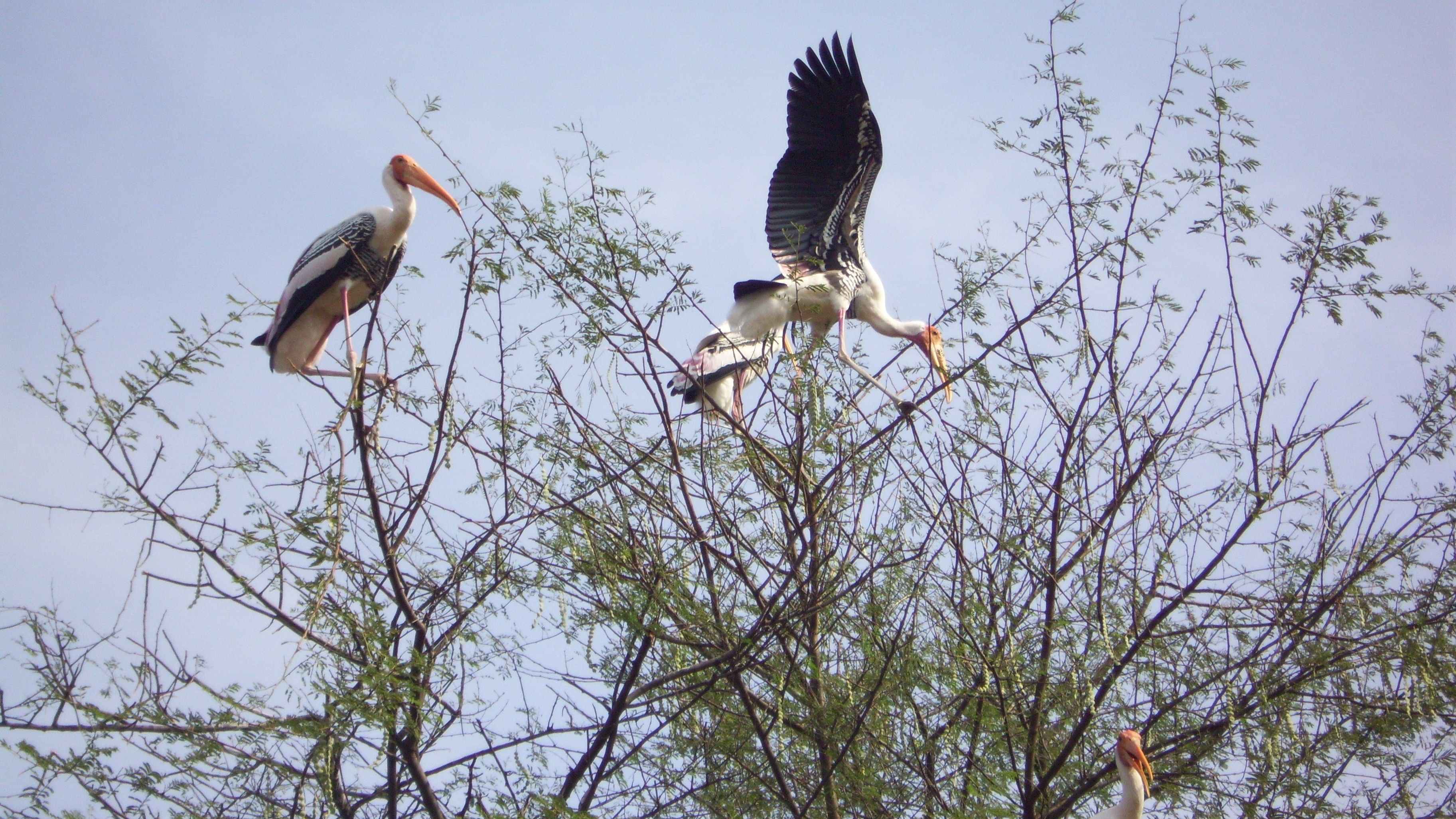
Painted storks at the Kokkarebellur Bird Sanctuary in Mandya district.
Photos: K Karunakaran
Recently, the welcome news about the mass arrival of migratory winged beauties prompted me to rush to meet them at their favourite habitat in Kokkarebellur village, in Maddur taluk, near Mandya. According to some, Kokkarebellur means ‘hamlet of storks’. Another version is that ‘kokkare’ means stork, and ‘bellur’ means village of jaggery in Kannada, and hence the name.
This 300-year-old village is only about 12 km from Maddur and 80 km from Bengaluru. A narrow road, deviating from the Bengaluru-Mysuru highway, took me through a picturesque scenery, flush with green fields of sugarcane, paddy and swaying coconut palms.
Soon, I could see several birds in flight dotting the sky above the fields, confirming that I had reached my destination. The nondescript hamlet had all the props of a typical rural scene – small tiled mud houses lining narrow streets, tall haystacks, bullock carts carrying loads of sugarcane, their bells jingling all the way and cows and buffaloes resting under the shade of trees.
I could feel the silence all around being broken by chirping sounds from above. Painted storks, with white, black and pink plumes shining in the morning sun were seen busily feeding on fruits, some tending to their chicks, others grooming themselves, checking their long wingspans. A few darted to adjacent tree tops, all the while making clicking sounds with their long yellow beaks. The delicate pink colour on the edges of the plumes, along with the contrasting black give them a paintbrush-stroked look, hence the name painted storks.
Some storks appeared to be posing for the cameras, with their huge wings stretched out and looking down at me. A few white spot-billed pelicans were seen perched on other trees, their yellow beaks and sagging skin bags hanging below their throats. Several large nests built with dry twigs and leaves adorned the treetops, holding young and noisy chirping chicks.
A borderless sanctuary
This village is the natural habitat for these migratory painted birds who visit the locale every year to feed, breed and nurture their chicks till they are ready for flight. The natural bird sanctuary here has been labelled the Kokkarebellur Pelicanry.
The uniqueness of this place is that the entire village is a borderless protected sanctuary. ‘Hejjarle balaga’ (meaning ‘relatives of pelicans’), a naturalists’ group also works with the forest department and the villagers in providing protection to these winged visitors. Over 130 bird species have been sighted in and around this village.
Water birds like spot-billed pelicans and black-headed ibis were roosting on the trees here. These birds also looked magnificent in their striking plumage.
During nesting, each nest is said to contain two to three dotted, dull-white eggs. Once the eggs hatch, the birds will be seen shading their chicks with outstretched wings. The chicks are always hungry and require a lot of food. Within months, they are nearly as large as their parents.
The spot-billed pelican or grey pelican is only half as tall as the stork, chiefly grey and greyish white, with short, stout legs and large, webbed feet. Its bill is flat and enormous, with an elastic bag of purple skin hanging below it. In spite of their size difference, the pelicans are considerably agile and are often seen soaring in circles in the company of storks, with whom they share their nesting colonies.
The neighbourhood
The symbiotic coexistence between the villagers and the birds goes back centuries. Viewed as harbingers of good fortune, the birds are welcomed by villagers each season as they set up nests on the tree canopies of ficus, tamarind and acacia.
People of Kokkarebellur believe that it is their duty to care for and protect the birds that nest on the trees in their backyard. Their children are also sensitised to carry on this tradition. Agriculture, the primary source of livelihood in the village, has flourished due to the use of guano, organic manure prepared out of bird droppings. Nutrient-rich bird droppings are allowed to accumulate in pits dug under the trees, and are mixed with silt before application in the fields.
The Shimsha river, along with several small tanks and ponds in the neighbourhood, provides these birds with an abundant supply of fish, supplemented by the fruits of the trees. The storks and pelicans arrive from distant locations, and reach Kokkarebellur soon after the monsoon season (October-December) and re-migrate to their distant homelands in summer, by June.
The local women are very sentimental about these birds and say that for them, these birds are like their own married daughters coming home for delivery!